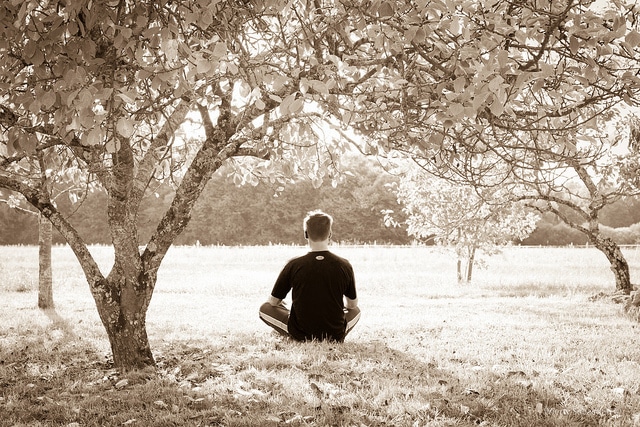I’ve gone through bouts of situational depression since I was a teenager. I’m lucky to have never been diagnosed with chronic depression (when you have more bad days than good for at least two years), but I’ve had periods of weeks, sometimes months, when the critical, cycling thoughts known as rumination take over and sap my energy, sometimes almost without my realizing what’s happening. It usually happens when I’m feeling helpless or stuck — in a job, relationship, or other life situation. Happily, it’s getting easier to navigate the bouts as I get older, thanks to several tools I’ve picked up along the way, including a few I want to share today.
“Clarity comes with the giving up of self,” Alan Watts wrote in The Joyous Cosmology, the 1962 chronicling of his experiences with LSD, mescaline, and psilocybin. He was talking about the inherent nature of psychedelics to help with this practice—the letting go of the self—but it’s also a hallmark of another consciousness-altering practice that Watts championed: meditation. His words resonate with me as someone who’s struggled with depression, a mental illness often characterized as thinking about the self too much.
It makes sense that using meditation would help integrate any lessons you’ve learned about yourself (and any unhealthy, depressive thought patterns you may have) during a psychedelic experience. For a lot of people, psychedelics and meditation go hand in hand — both are used to observe yourself from a different perspective and find spiritual meaning. Research also shows that psychedelics like psilocybin mushrooms and meditative states both decrease activity in areas of the brain associated with depression, which is very good news for the estimated 15.7 million Americans that struggle with it.
Psychedelic researcher and writer Neal Goldsmith wrote, “As dreams are the fuel of psychoanalysis, so are psychedelics the fuel of meditation.” While psychedelics can help you get out of your head and see your reality outside of the “self” that Watts encourages us to let go of, the revelations of a psychedelic experience can fade and those creeping, negative thoughts can come back. When this happens to me, I turn to these two meditations.
Two Meditations to Relieve Depression
Setting up a meditation practice at home is a fairly simple task. All you need is some floor space, a pillow, fifteen minutes, and some quiet. While a daily meditation practice of any kind is helpful for integrating a psychedelic experience, there are meditations found in the branch of yogic sciences called kundalini yoga, that are specifically designed to break through depressive thought patterns. There are a variety of kundalini meditations for depression, but the ones I’m going to share today are two classic meditations originally taught by the kundalini teacher Yogi Bhajan. They can be used in conjunction with a daily home practice, but even if you don’t practice meditation regularly, they can still be helpful for calming your mind and opening your heart.
(As a note: I am not a trained kundalini yoga teacher or therapist, just a practitioner sharing what has worked for me. These meditations are only mildly strenuous, but if you have any concerns about your health, check with your doctor before endeavoring either.)
A Meditation to Recharge
This meditation is used as an antidote for mild to serious depression and is an all around spirit-lifter. Sit on a pillow or folded blanket on the floor in a comfortable cross-legged position with a straight spine (or sit in a chair, if sitting on the floor for long periods of time is painful for you). Hold both of your arms out in front of you, parallel to the ground. Make a fist with your right hand and cup your left hand around it. Your thumbs should be touching and pointing straight up. To begin the meditation, inhale for 5 seconds, then exhale for 5 seconds, then hold the breath out for 15 seconds. Keeping your shoulders back and your heart lifted, continue breathing like this for 3 – 5 minutes (eventually, you can work up to 11 minutes). If your arms start to get tired, concentrate on your breath, funneling it into your arms as a means to keep them elevated. When your timer goes off, inhale and hold the breath for 5 seconds, then exhale.
A Meditation for Acute Depression
Whereas the meditation above is good for relieving mild to serious depression, this meditation, which involves chanting a mantra, is designed for even the most acute depression. The mantra is “Wahe Guru” (pronounced “Wah-hay-goo-roo”), which in Sanskrit means, “the ecstasy that brings us out of darkness into light.” Again, sit on a pillow on the floor or in a chair with a straight spine. Bring the backs of your hands together about six inches in front of you. Your arms will naturally fall to the side; keep them parallel to the ground. Your thumbs should be pointing toward the ground. Keeping your shoulders back and your heart lifted, inhale. On your exhale, you will repeat the mantra “Wahe Guru” quickly 16 times. Inhale again, and repeat the exercise, chanting, “Wahe Guru” on the exhale. If you can’t say it 16 times on the exhale, don’t worry about it — just do your best. If you’d like more instruction on this meditation (it can be helpful to hear the cadence and rhythm of the mantra), here’s a video from Spirit Voyage that can help guide you through it.
The only advice I have to give is this: really try when you’re doing these meditations. That might sound strange, but after a few minutes, your arms will probably start to feel tired — you may be tempted to let them fall or stop completely. If you feel you absolutely cannot keep your arms up, let them rest while continuing to breathe and chant. Beyond any physical limitations, it’s easy to feel silly doing meditation, particularly ones that involve chanting. Do your best to let go of those critical thoughts and funnel that energy instead into the rhythm of the mantra and into your breath, which will also help you keep your arms strong. If you use your breath and stamina to power through any discomfort, you’ll feel the benefits at the end of the time limit.
Incorporating Meditation into Psychedelic Integration
These meditations can be used as often as you need them. They work best as part of a regular meditation or yoga practice, but even used sporadically, they can be incredibly beneficial. If you’re still struggling with depression, consider finding a therapist who is familiar with psychedelic integration or try other therapeutic practices at home like journaling. By taking up mindful practices like these, you can make the most of a psychedelic experience and take a step toward taking control of depressive thought patterns.











